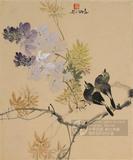宋高宗書孝經馬和之繪圖 冊 諸侯章(畫)
推薦分享
資源連結
連結到原始資料 (您即將開啟新視窗離開本站)後設資料
- 資料識別:
- 故畫001224N000000005
- 資料類型:
- 類型:繪畫
- 型式:靜態圖像
- 著作者:
- 馬和之
- 主題與關鍵字:
- 帝王 獸力車 官員(臣) 侍從(侍女、童僕) 軍士 百姓 馬
- 出版者:
- 數位化執行單位:國立故宮博物院
- 格式:
- 本幅 28.5x37.2公分、全幅 40x88公分
- 關聯:
- 石渠寶笈初編(御書房),下冊,頁865&*故宮書畫錄(卷六),第四冊,頁164&*《孝經》為宣揚孝道和孝治思想的儒家經典,此圖冊將孝親推廣至立身、事君,由不同階層角度,來描繪孝道的表現。原書畫本為手卷,後改裝成冊。冊後有宋逢丑及趙孟頫諸跋,皆肯定書法出於高宗。元夏元彥嘗云:「高宗每書毛詩三百篇,令和之圖寫」,故後人多將此類教化題材歸於馬和之所作。然細審其畫風,則近似南宋院畫家李唐、蕭照等人。本件選自第五幅。&*The classic of Filial Piety is exalted as the major text regarding the principle of filial piety in Confucian thought. This album illustrates the chapter describing how filial relations produce a strengthened self and furthermore emphasizes the ways in which proper relations between ruler and subject lead to virtuous behavior and a harmonious society. The painting and calligraphy were originally in the form of a hand scroll, later being cut apart into album leaves. Following the album are colophons by Sung Feng-ch'ou and Chao Meng-fu (1254-1322), who confirm the calligraphy as coming from the hand of emperor Kao-tsung. Furthermore, Hsia Yüan-yen of the Yüan dynasty (1279-1368) wrote, "Kao-tsung copied out The Classic of Filial Piety three hundred times and ordered Ma Ho-chih to make illustrations." When later connoisseurs encountered such didactic paintings, they often ascribed them to Ma. However, close examination of these paintings reveals them to be closer in style to that Li T'ang and Hsiao Chao, two other leading court painters of the mid-12th century. The fifth leaf from the album is illustrated here.&*1.林莉娜,〈高宗書孝經馬和之繪圖-士章〉,收入國立故宮博物院編,《宋代書畫冊頁名品特展》(臺北:國立故宮博物院,1995年初版一刷),頁274-276。 2.林莉娜,〈「七十件書畫冊頁名品特展」精選(七) — 高宗書孝經馬和之繪圖—士章〉,《故宮文物月刊》,第153期(1995年12月),頁82-85。
- 管理權:
- 國立故宮博物院
授權聯絡窗口
- 國立故宮博物院圖像授權、出版授權、影音資料授權-申請流程說明
http://www.npm.gov.tw/zh-TW/Article.aspx?sNo=03003061






